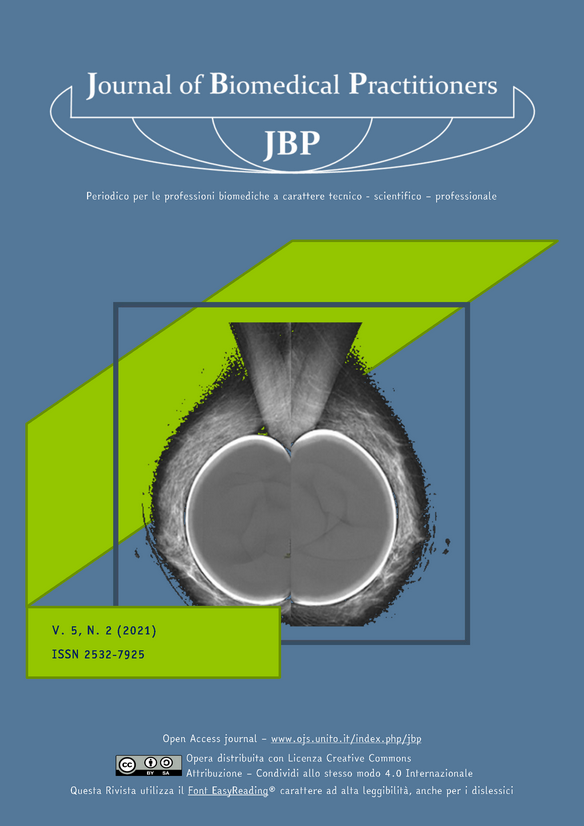Credit achievement ability during distance learning era: the case of Statistics in Medicine course
Contenuto principale dell'articolo
Abstract
AIM
In this study, the effects of the DL on academic career were investigated.
BACKGROUND
Distance Learning (DL) became mandatory in Italy from March 2020, due to COVID19 emergency.
DESIGN
The performances of students in Medical Statistics course of the Nursing degree in three campus of the University of Turin (Aosta, Beinasco and Cuneo) in the Academic Years 2019-2020 and 2020-2021 were considered.
METHODS
The study is based on 308 students, 48% of whom both attended the lessons and took the exams in DL. The effect of DL on student’s performance was evaluated using Logistic regression models and the results are showed in terms of odds ratios adjusted for gender, age and campus.
RESULTS
The results show that DL did not bring particular limitations to the students, highlighting on the contrary evident benefits in terms of organization and management of lessons and exams. Moreover, the level of students’ satisfaction at the end of the course increased in DL.
CONCLUSION
DL seems to do not affect the student’s ability on achieve credits, at least in mathematical subjects. More investigations are needed considering all courses’ types.
Downloads
Dettagli dell'articolo
Gli autori mantengono i diritti sulla loro opera e cedono alla rivista il diritto di prima pubblicazione dell'opera, contemporaneamente licenziata sotto una Licenza Creative Commons - Attribuzione che permette ad altri di condividere l'opera indicando la paternità intellettuale e la prima pubblicazione su questa rivista.
Riferimenti bibliografici
[2] Casado-Aranda, L.-A., S.S. Caeiro, J. Trindade, A. Paço, D. Lizcano Casas, and A. Landeta. 2020. “Are Dis-tance Higher Education Institutions Sustainable Enough? – A Comparison between Two Distance Learning Universi-ties.” International Journal of Sustainability in Higher Education. https://doi.org/10.1108/IJSHE-07-2020-0260.
[3] Co, Michael, and Kent-Man Chu. 2020. “Distant Surgical Teaching during COVID-19 - A Pilot Study on Final Year Medical Students.” Surgical Practice 24 (3): 105–9. https://doi.org/10.1111/1744-1633.12436.
[4] “Didattica alternativa.” 2020. Università di Torino. March 25, 2020. https://www.unito.it/ateneo/gli-speciali/coronavirus-aggiornamenti-la-comunita-universitaria/didattica-alternativa.
[5] “DPCM-8-Marzo-2020-1.Pdf.” n.d. Accessed March 5, 2021. https://re.istruzioneer.gov.it/wp-content/uploads/sites/10/2020/04/DPCM-8-marzo-2020-1.pdf.
[6] Ferraro, F.V., F.I. Ambra, L. Aruta, and M.L. Iavarone. 2020. “Distance Learning in the Covid-19 Era: Percep-tions in Southern Italy.” Education Sciences 10 (12): 1–10. https://doi.org/10.3390/educsci10120355.
[7] Foo, C.-C., B. Cheung, and K.-M. Chu. 2021. “A Comparative Study Regarding Distance Learning and the Con-ventional Face-to-Face Approach Conducted Problem-Based Learning Tutorial during the COVID-19 Pandemic.” BMC Medical Education 21 (1). https://doi.org/10.1186/s12909-021-02575-1.
[8] Halpern, C. 2021. “Distant Learning: The Experiences of Brazilian Schoolteachers during the Covid-19 School Closures.” Journal of Ethnic and Cultural Studies 8 (1): 206–25. https://doi.org/10.29333/ejecs/595.
[9] Jacques, S., A. Ouahabi, and T. Lequeu. 2021. “Remote Knowledge Acquisition and Assessment during the Covid-19 Pandemic.” International Journal of Engineering Pedagogy 10 (6): 120–38. https://doi.org/10.3991/IJEP.V10I6.16205.
[10] Kaila, E., and H. Kajasilta. 2020. “Blended or Distance Learning?: Comparing Student Performance between Uni-versity and Open University.” Lecture Notes in Computer Science (Including Subseries Lecture Notes in Artificial Intelligence and Lecture Notes in Bioinformatics) 12128 LNCS: 477–84. https://doi.org/10.1007/978-3-030-50578-3_32.
[11] Ramos-Morcillo, A.J., C. Leal-Costa, J.E. Moral-García, and M. Ruzafa-Martínez. 2020. “Experiences of Nursing Students during the Abrupt Change from Face-to-Face to e-Learning Education during the First Month of Confine-ment Due to COVID-19 in Spain.” International Journal of Environmental Research and Public Health 17 (15): 1–15. https://doi.org/10.3390/ijerph17155519.
[12] Ziganshin, A.M., V.A. Mudrov, S.F. Nasyrova, V.Z. Galimzyanov, D.A. Salimonenko, A.Yu. Alekseeva, I.M. Nasi-bulin, and A.G. Yaschuk. 2020. “Distance Learning Opportunities during the COVID-19 Epidemic.” Kazan Medical Journal 101 (6): 876–82. https://doi.org/10.17816/KMJ2020-876.

